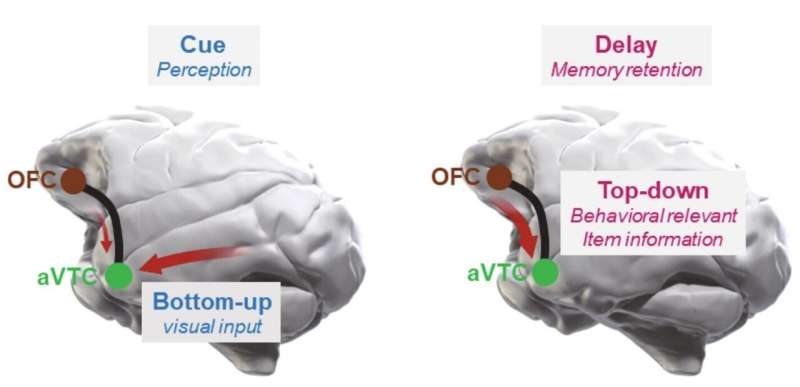This article has been reviewed according to Science X's editorial process and policies. Editors have highlighted the following attributes while ensuring the content's credibility:
fact-checked
peer-reviewed publication
proofread
Piecing the puzzle together: How different brain regions contribute to visual object memory

Visual object memory refers to our brain's ability to store, recognize, and recall visual information about objects we perceive. This capability is essential for interacting with the world, influencing learning, problem-solving, navigation, and social interactions. Without effective visual object memory, these activities would be nearly impossible. Consequently, many neuroscientists have been making dedicated attempts to uncover the mechanisms behind this critical aspect of cognition in both humans and animals.
Numerous studies on primates engaged in memory tasks have established that the anterior ventral temporal cortex (aVTC) is crucial for visual object memory. Neurons in this region can represent complex visual objects, suggesting that they can function in visual object memory even without direct visual input, relying instead on regulatory signals from higher cognitive areas. Despite this understanding, the specifics of this "top-down" regulation and the broader functional network that includes aVTC remain unclear.
In an effort to answer these questions, a research team from Japan conducted an in-depth investigation to shed light on this elusive issue. Led by Senior Research Scientist Toshiyuki Hirabayashi from the National Institutes for Quantum Science and Technology (QST), they conducted various types of experiments on macaques performing visual memory tasks. Their latest paper was published in Nature Communications on July 10, 2024 and was co-authored by Takafumi Minamimoto from the Advanced Neuroimaging Center, QST.
First, the researchers ran functional positron emission tomography scans on macaques during a visual recall task, which enabled them to pinpoint brain regions with higher activity by measuring minute changes in blood flow. They combined these measurements with functional magnetic resonance imaging data, taken previously over a large population of macaques, which quantified the connectivity between different brain areas. In this way, they identified specific nodes within the aVTC and the orbitofrontal cortex (OFC) as essential members of the network governing visual object memory.
To cement these findings, they conducted chemogenetic silencing experiments. Simply put, they genetically modified the OFC of macaques using a viral vector to introduce custom-designed receptors to the neurons. These receptors prevent the firing of the neurons, but only in the presence of a very specific designer drug. The team observed that the monkeys performed significantly worse in the visual recall tasks when the OFC was chemically silenced, which did not impair their visual perception in any way.

Nonetheless, the researchers wanted to take their analysis one step further, and so, they explored the small-scale details governing visual object memory in the aVTC and OFC.
"Both the macroscale identification of brain network nodes and the subsequent microscale, cellular-level understanding of causal information flow along the identified nodes are required for a comprehensive understanding of the network mechanisms underpinning object memory," remarks Hirabayashi.
To this end, they conducted single-neuron recordings in the aVTC of the same macaques used in previous experiments, assessing the memory-related activity and higher-order modulation in these neurons. They found that the memory-related activity of individual aVTC neurons, but not perception-related activity, was specifically attenuated by OFC silencing. This was consistent with the behavioral results obtained earlier.
Furthermore, similar changes in neuronal activity occurred when the monkeys made a mnemonic error in the task prior to OFC silencing, suggesting the behavioral relevance of the memory-related activity in individual aVTC neurons, which was supported by top-down inputs from the OFC.
Together, these analyses helped the team obtain a detailed understanding of the mechanisms underpinning short-term visual object memory in primates. Given that our brains share many functional and structural characteristics with those of these animals, the findings of this study can ultimately help in understanding ourselves better as well. Worth noting, this could have important implications in medicine.
As Hirabayashi explains, "The discovered network mechanisms in non-human primates could provide a mechanistic understanding of related memory deficits that occur in human dementia." Adding, he says, "The artificial neuromodulation of the currently discovered network in patients with dementia might restore their visual memory functions."
More information: Toshiyuki Hirabayashi et al, Multiscale chemogenetic dissection of fronto-temporal top-down regulation for object memory in primates, Nature Communications (2024). DOI: 10.1038/s41467-024-49570-w



















